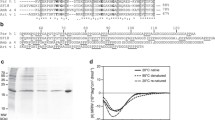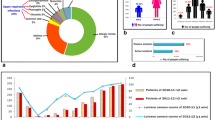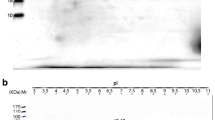Summary
Background
Fraxinus excelsior (Ash) is a common tree and is important cause of winter–spring pollinosis in many temperate regions in the world. In this study, a high molecular weight allergen from ash pollen was identified.
Methods
In all, 20 individuals allergic to ash participated in the study. Characterization and immunoreactivity of ash pollen proteins was performed using sodium dodecyl sulfate polyacrylamide electrophoresis (SDS-PAGE), two-dimensional (2D) gel electrophoresis and immunoblotting.
Results
Immunoglobulin E (IgE)-binding proteins with apparent molecular mass ranging from 9 to 110 kDa were detected in ash pollen extract. Serum IgE of 7 (35%) patients reacted with a 53-kDa protein band. Analysis of 2D immunoblots showed several IgE-binding proteins. Moreover, mass spectrometry analysis indicated that the 53-kDa allergen was homologous to calreticulin.
Discussion
We defined a novel allergen from F. excelsior pollen with a molecular weight of about 53 kDa. This allergen could be considered as an important high molecular weight allergenic protein for further studies on cross-reactivity and development of diagnostic and therapeutic approaches.


Similar content being viewed by others
Abbreviations
- 2‑DE:
-
Two-dimensional electrophoresis
- BSA:
-
Bovine serum albumin
- CBB:
-
Comassie brilliant blue
- CRT:
-
Calreticulin
- ER:
-
Endoplasmic reticulum
- HMW:
-
High molecular weight
- IAARI:
-
Immunology, Asthma and Allergy Research Institute
- IEF:
-
Isoelectric focusing
- IPG:
-
Immobilized pH gradient
- IPI:
-
International protein index
- LiquidDAB+:
-
High-sensitivity liquid diaminobenzidine
- MALDI:
-
Matrix assisted laserdesorption/ionization
- MW:
-
Molecular weight
- PVDF:
-
Polyvinylidene fluoride
- SDS-PAGE:
-
SDS-polyacrylamide gel electrophoresis
- TBS:
-
Tris-buffered saline
- TOF:
-
Time of flight
References
Poncet P, Senechal H, Clement G, Purohit A, Sutra JP, Desvaux FX, et al. Evaluation of ash pollen sensitization pattern using proteomic approach with individual sera from allergic patients. Allergy. 2010;65:571–80.
Wallander E. Systematics of Fraxinus (Oleaceae) and evolution of dioecy. Plant Syst Evol. 2008;273:25–49.
Lee HS, Park SH, Wallander E, Chang C‑S. A flavonoid survey of Fraxinus (Oleaceae) in eastern Asia, and the overlooked species Fraxinus hopeiensis T. Tang in northern China. Biochem Syst Ecol. 2012;41:150–6.
Albert B, Morand-Prieur M‑E, Brachet S, Gouyon P‑H, Frascaria-Lacoste N, Raquin C. Sex expression and reproductive biology in a tree species, Fraxinus excelsior L. C R Biol. 2013;336:479–85.
García B, Lizaso M, Moreno C, Rodríguez R, Villalba M, Ledesma A, et al. 5 Oleaceae-induced pollinosis in an area with exposure to olive and ash trees. J Investig Allergol Clin Immunol. 2011;21:34.
Gassner M, Schmid-Grendelmeier P, Clot B. Ash pollen allergy and aerobiology. Allergo J Int. 2019;28:289–98.
Majd A, Shoushtari MS, Moin M, Nejad MM, Zandieh F, Bayat P, et al. Pollen database registry in Iran. Iran J Allergy Asthma Immunol. 2018;17:91–2.
Barderas R, Purohit A, Papanikolaou I, Rodríguez R, Pauli G, Villalba M. Cloning, expression, and clinical significance of the major allergen from ash pollen, Fra e 1. J Allergy Clin Immunol. 2005;115:351–7.
Hemmer W, Focke M, Wantke F, Götz M, Jarisch R, Jäger S, et al. Ash (Fraxinus excelsior)-pollen allergy in central Europe: specific role of pollen panallergens and the major allergen of ash pollen, Fra e 1. Allergy. 2000;55:923–30.
Hrabina M, Purohit A, Oster J‑P, Papanikolaou I, Jain K, Pascal P, et al. Standardization of an ash (Fraxinus excelsior) pollen allergen extract. Int Arch Allergy Immunol. 2007;142:11–8.
Imhof K, Probst E, Seifert B, Regenass S, Schmid-Grendelmeier P. Ash pollen allergy: reliable detection of sensitization on the basis of IgE to Ole e 1. Allergo J Int. 2014;23:78–83.
Niederberger V, Purohit A, Oster JP, Spitzauer S, Valenta R, Pauli G. The allergen profile of ash (Fraxinus excelsior) pollen: cross-reactivity with allergens from various plant species. Clin Exp Allergy. 2002;32:933–41.
Robledo-Retana T, Zenteno E, Agundis-Mata M, Pereyra-Morales M, Calderón-Segura M, Calderón-Ezquerro M. Detection of immunogens from Fraxinus spp. pollen grains. Aerobiologia. 2015;31:403–10.
Mas S, Torres M, Garrido-Arandia M, Salamanca G, Castro L, Barral P, et al. Ash pollen immunoproteomics: identification, immunologic characterization, and sequencing of 6 new allergens. J Allergy Clin Immunol. 2014;133:923–6.
Sharif Shoushtari M, Majd A, Pourpak Z, Shahali Y, Moin M, Eslami MB. Differential allergenicity of mature and immature pollen grains in Shasta daisy (Chrysanthemum maximum Ramond). Iran J Allergy Asthma Immunol. 2013;12:99–106.
Bradford MM. A rapid and sensitive method for the quantitation of microgram quantities of protein utilizing the principle of protein-dye binding. Anal Biochem. 1976;72:248–54.
Assarehzadegan MA, Sankian M, Jabbari F, Tehrani M, Varasteh A. Expression of the recombinant major allergen of Salsola kali pollen (Sal k 1) and comparison with its low-immunoglobulin E‑binding mutant. Allergol Int. 2010;59:213–22.
Ghosal K, Saha B, Bhattacharya SG. Clinical and immuno-proteomic approach on Lantana camara pollen allergy—a major health hazard. Allergy Asthma Clin Immunol. 2016;12:33.
Assarehzadegan M‑A, Khodadadi A, Amini A, Shakurnia A‑H, Marashi SS, Ali-Sadeghi H, et al. Immunochemical characterization of Prosopis juliflora pollen allergens and evaluation of cross-reactivity pattern with the most allergenic pollens in tropical areas. Iran J Allergy Asthma Immunol. 2014;4:74–82.
Assarehzadegan MA, Sankian M, Jabbari F, Tehrani M, Falak R, Varasteh A. Identification of methionine synthase (Sal k 3), as a novel allergen of Salsola kali pollen. Mol Biol Rep. 2011;38:6–73.
Mousavi F, Majd A, Shahali Y, Ghahremaninejad F, Shoormasti RS, Pourpak Z. Immunoproteomics of tree of heaven (Ailanthus atltissima) pollen allergens. J Proteomics. 2017;154:94–101.
Assarehzadegan MA, Shakurnia A, Amini A. The most common aeroallergens in a tropical region in Southwestern Iran. World Allergy Organ J. 2013;6:7.
Fereidouni M, Hossini RF, Azad FJ, Assarehzadegan M‑A, Varasteh A. Skin prick test reactivity to common aeroallergens among allergic rhinitis patients in Iran. Allergol Immunopathol (Madr). 2009;37:73–9.
Barderas R, Purohit A, Rodriguez R, Pauli G, Villalba M. Isolation of the main allergen Fra e 1 from ash (Fraxinus excelsior) pollen: comparison of the natural and recombinant forms. Ann Allergy Asthma Immunol. 2006;96:557–63.
Roth M. The C1q-receptor-calreticulin-contributes to the pathogenesis of asthma. J Respir Med Lung Dis. 2016;1:1002.
Abolhassani M, Roux KH. cDNA cloning, expression and characterization of an allergenic 60s ribosomal protein of almond (Prunus dulcis). Iran J Allergy Asthma Immunol. 2009;8:77–84.
Radauer C, Bublin M, Wagner S, Mari A, Breiteneder H. Allergens are distributed into few protein families and possess a restricted number of biochemical functions. J Allergy Clin Immunol. 2008;121:847–852.e7.
Acknowledgements
This study was supported by Immunology, Asthma and Allergy Research Institute (IAARI), Children’s Medical Center, Tehran University of Medical Sciences (grant # 93-03-40-27007).
Author information
Authors and Affiliations
Corresponding author
Ethics declarations
Conflict of interest
M. Sharif Shoushtari, A. Majd, M.-A. Assarehzadegan, S. Fanuel, M. Moin, T. Nejadsattari, R. S. Shoormasti,M. Badalzadeh, S. Tajik, M.R. Fazlollahi, B. Tayebi, Z. Pourpak and G.A. Kardar declare that they have no competing interests.
Rights and permissions
About this article
Cite this article
Sharif Shoushtari, M., Majd, A., Assarehzadegan, MA. et al. Identification of a 53 kDa protein, as a new high molecular weight allergen from Fraxinusexcelsior (Ash) pollen. Allergo J Int 29, 233–239 (2020). https://doi.org/10.1007/s40629-020-00129-3
Received:
Accepted:
Published:
Issue Date:
DOI: https://doi.org/10.1007/s40629-020-00129-3




